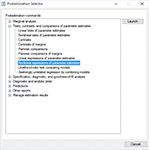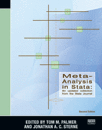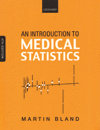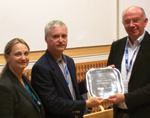Inside this issue
- See how fast Stata/MP can be
- In the spotlight: Easy-to-interpret, flexible survival-time treatment effects
- In the spotlight: What's next
- New from Stata Press
- New from the Bookstore
- Italian Stata Users Group meeting
- Metrika Consulting celebrates 25 years with StataCorp
- NetCourses®
- Public training schedule
- Stata 14.1
- Stata Conference Chicago 2016
See how fast Stata/MP can be

Stata has superb support for multicore computers. Stata/MP runs over half of Stata’s estimation commands at least 1.8 times faster on dual-core machines, at least 2.8 times faster on quad-core machines, and at least 4 times faster on computers with 8 cores.
In the spotlight: Easy-to-interpret, flexible survival-time treatment effects
In this spotlight, we reiterate the well-known point that the effect estimable from the Cox model parameters is difficult to interpret for nontechnical audiences. We illustrate why the Cox model is less flexible for estimating treatment effects than many researchers believe. Finally, we show how to use the new stteffects command to flexibly estimate an easy-to-interpret treatment effect.
In the spotlight: What's next

Explore the Postestimation Selector—a boring name for a nifty tool. Just click on Postestimation Selector in the Statistics menu. It will show you exactly what is available for whatever you have most recently estimated or most recently restored from previously saved estimations.
New from Stata Press

Meta-Analysis in Stata: An Updated Collection from the Stata Journal, Second Edition
Tom M. Palmer and Jonathan A. C. Sterne (editors)
Copyright: 2016
$48.00
New from the Bookstore

An Introduction to Medical Statistics, Fourth Edition
Martin Bland
Copyright: 2015
$44.75
Metrika Consulting celebrates 25 years with StataCorp

For 25 years, Metrika Consulting has been our valued distributor in the Nordic and Baltic countries.
NetCourses®
|
Introduction to Stata January 15–February 26, 2016 |
$95 |
|
Introduction to Statistical Graphics Using Stata January 15–February 26, 2016 |
$150 |
|
Introduction to Stata Programming January 15–February 26, 2016 |
$150 |
|
Advanced Stata Programming January 15–March 4, 2016 |
$175 |
|
Introduction to Univariate Time Series with Stata January 15–March 4, 2016 |
$295 |
|
Introduction to Panel Data Using Stata January 22–March 4, 2016 |
$295 |
|
Introduction to Survival Analysis Using Stata January 15–March 4, 2016 |
$295 |
Public training schedule
Using Stata Effectively: Data Management, Analysis, and Graphics Fundamentals
January 11–12, 2016
March 8–9, 2016
April 26–27, 2016
Aimed at both new Stata users and those who wish to learn techniques for efficient day-to-day use of Stata, this course teaches you to use Stata in a reproducible manner, making collaborative changes and follow-up analyses much simpler.
Structural Equation Modeling Using Stata
March 10–11, 2016
Learn how to illustrate, specify, and estimate structural equation models in Stata using Stata’s SEM Builder and the sem command. The course introduces several types of models, including path analysis, confirmatory factor analysis, full structural equation models, and latent growth curves.
Time-Series Analysis Using Stata
February 8–9, 2016
Learn how to efficiently use Stata for time-series analysis. Topics include data management, estimation of univariate and multivariate stationary and nonstationary time series, model selection, hypothesis testing, and interpretation.
Handling Missing Data Using Multiple Imputation
April 21–22, 2016
Learn all aspects of multiple-imputation (MI) analysis, including creation of MI data using the multivariate normal and chained-equations (or fully conditional specification) imputation methods, manipulation of MI data, and analysis of MI data.
Stata 14.1
Stata 14.1 is available now and is a no-cost update to Stata 14. Just type update query and follow the instructions. Stata 14.1 adds more features to Bayesian analysis, multiple imputation, IRT, mixed models, and much more.









